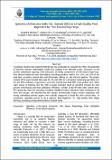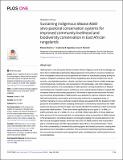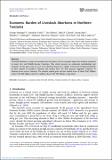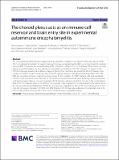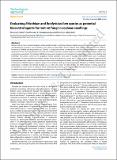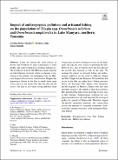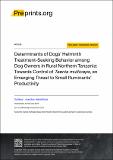Research Articles [LISBE]: Recent submissions
Now showing items 121-140 of 954
-
Spirulina (Arthrospira fusiformis, Gomont 1892) as a High-Quality Feed Ingredient for Nile Tilapia Fingerlings
(Tanzania Journal of science, 2023-08-23)A partially randomized experimental design was conducted to evaluate the effect and potential of spirulina species (Arthrospira fusiformis) isolated from Momela Lakes, Tanzania, on the growth, antioxidant capacity, feed ... -
Sustaining indigenous Maasai Alalili silvo-pastoral conservation systems for improved community livelihood and biodiversity conservation in East African rangelands Elkana HezronID*, Issakwisa B. N
(PLOS ONE, 2024-04-29)Alalili system is one among the fewest remnant African indigenous and local knowledge systems that is traditionally practiced by Maasai pastoral communities to conserve certain portions of rangeland resources such as ... -
Economic Burden of Livestock Abortions in Northern Tanzania
(Cambridge University press, 2024)Livestock abortion is a source of economic loss for farmers, but its economic impact has not been estimated in many Low and Middle-Income Countries. This article presents an estimation methodology and estimates for the ... -
The choroid plexus acts as an immune cell reservoir and brain entry site in experimental autoimmune encephalomyelitis
(Fluids and Barriers of the CNS, 2023)The choroid plexus (ChP) has been suggested as an alternative central nervous system (CNS) entry site for CCR6+ Th17 cells during the initiation of experimental autoimmune encephalomyelitis (EAE), an animal model for ... -
Enhancing Food Grains Storage Systems through Insect Pest Detection and Control Measures for Maize and Beans: Ensuring Food Security Post-COVID-19 Tanzania
(MDPI, 2024-02-21)COVID-19 poses a significant threat to the present and future of mankind. The emergence of diverse strains during the pandemic creates uncertainty regarding their disappearance or resurgence. Lockdown measures and travel ... -
Botanical extracts control the fungal pathogen Colletotrichum boninense in smallholder production of common bean
(Springer link, 2024-04-11)Anthracnose caused by Colletotrichum spp. remains an intractable problem in the most common bean (Phaseolus vulgaris) production areas worldwide and can cause total yield loss. Many smallholder farmers are familiar with ... -
Pollen Amount and Viability in Mchare and Selected Wild (AA) Banana (Musa acuminata) Genotypes: Prospects for Breeding
(HortScience, 2024-04-10)East African diploid cooking bananas, commonly called Mchare, are a staple crop for millions of subsistence farmers in Tanzania, particularly in the Pangani region in northern Tanzania. Several pathogens constrain Mchare ... -
Human activities affecting lesser flamingo (Phoeniconaias minor) habitat in Momella lakes, Tanzania
(Taylor & Francis, 2024-05-01)Land use/land cover (LULC) change, caused by human activities, can strongly affect wildlife species and their habitats. Yet, human impacts onto lakes and associated indicator bird species such as the lesser flamingos ... -
Evaluating Rhizobium and Bradyrhizobium species as potential biocontrol agents for root rot fungi in soybean seedlings
(Technology in Agronomy, 2024)Soybean (Glycine max) is among the legumes which are highly prone to soil-borne pathogens which causes root-rot diseases limiting the growth and development resulting to low yield of plants. This study was conducted to ... -
Characterization of phenotypic traits associated with anthracnose resistance in selected common bean (Phaseolus vulgaris L.) breeding material
(Elsevier Ltd, 2024-02-27)Anthracnose caused by Colletotrichum lindemuthianum is the major common bean disease worldwide causing complete yield loss under favourable disease conditions. This study aimed to determine phenotypic traits associated ... -
Effectiveness of complementary sorting methods in reducing aflatoxin contamination in groundnuts
(BRILL WAGENINGEN ACADEMIC, 2023-12-07)Aflatoxin contamination of staple foods remains a public health concern in many tropical and sub-tropical countries. In sub-Saharan Africa, groundnuts are a significant source of aflatoxin (AF) in vulnerable populations such ... -
Climate-smart aquaculture in Tanzania: Assessment of transitional and heavy metals concentrations in a commonly used local feed ingredient for Tilapia farming
(IJASRE, 2023-11)A study conducted from January through May 2023 to assess the concentrations of heavy and transitional metals in a commonly used local feed ingredient in a farmed Nile tilapia diet (Oreochromis niloticus) in Tanzania. ... -
Climate-smart solutions for tropical mountain environments
(Frontiers, 2024-02-15) -
Impact of anthropogenic pollution and artisanal fishing on the population of Tilapia spp. Oreochromis niloticus and Oreochromis amphimelas in Lake Manyara, northern Tanzania
(Springer Nature B.V, 2024-01-17)Lakes are among the main sources of protein and livelihood to huge communities of rural people, and some of them house endemic fish species. The livelihood of about 200,000 rural people depends on Lake Manyara resources ... -
Fish predation affects invertebrate community structure of tropical temporary ponds, with downstream effects on phytoplankton that are obscured by pesticide pollution
(Elsevier Ltd., 2024-02-14)Aquatic biota of tropical temporary ponds typically experience a wide range of stressors that can drive the structure and dynamics of natural communities. Particularly in regions with intense agricultural activity, aquatic ... -
Complete genome sequence of Brucella abortus isolated from a human blood culture sample in Tanzania
(American society for microbiology, 2024-01-30)Brucella abortus causes infections in humans and livestock. Bacterial isolates are challenging to obtain, and very little is known about the genomic epidemiology of this species in Africa. Here, we report the complete ... -
The assessment of neuronal plasticity following sciatic nerve injuries in rats using electron microscopy and stereological methods
(Elsevier, 2024-02-06)The transmission of signals to the cell body from injured axons induces significant alterations in primary sensory neurons located in the ganglion tissue, the site of the perikaryon of the affected nerve fibers. Disruption ... -
Review of the Current Status on Livestock Abortigenic Diseases Surveillance in Africa and Asia.
(Pre prints.org, 2024-03-08)Introduction: Livestock abortigenic agents, are microorganisms that lead to premature foetal death and expulsion before completion of the gestation period, are common in Africa and Asia. Abortion events cause economic ... -
Determinants of Dogs’ Helminth Treatment-Seeking Behavior among Dog Owners in Rural Northern Tanzania.
(Pre prints.org, 2024-02-20)Taeniid infections pose a significant threat to both animal and public health, as certain tapeworms within this group can also infect humans, potentially leading to severe health conditions. Therefore, this calls for ... -
Farming systems and soil fertility management practices in smallholdings on the southern slopes of Mount Kilimanjaro, Tanzania
(Frontiers, 2024-02-16)In the northern part of Tanzania, the slopes of Mount (Mt.) Kilimanjaro are the most important areas, both in terms of socio-economic development and ecological succession. The main agricultural systems in the area are ...

